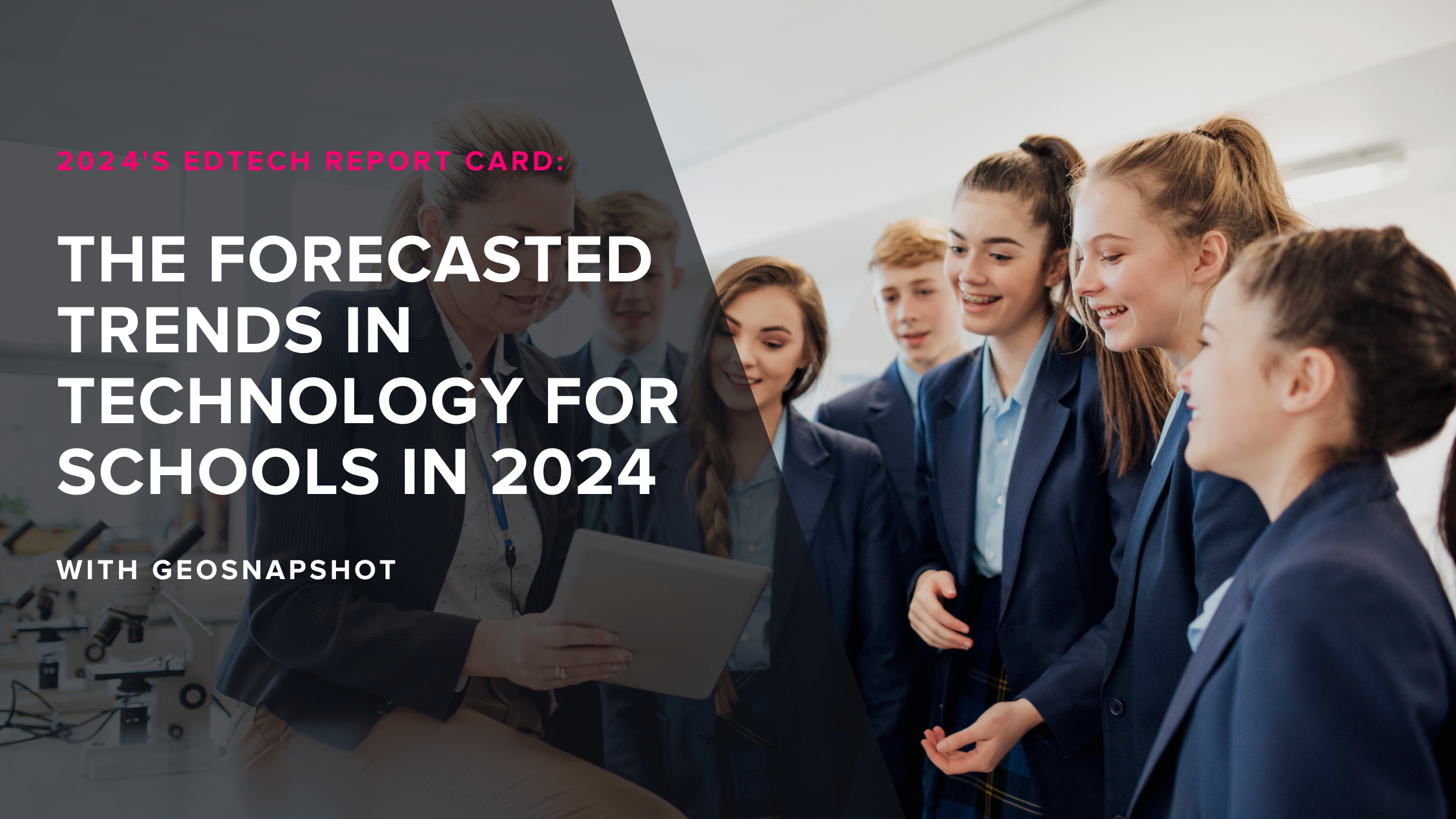
With a market value projected to reach $250 billion this year, unprecedented levels of investment in the EdTech sector are acknowledging this technology’s powerful potential to revolutionize traditional teaching methods and make personalized, engaging and innovative learning environments accessible to students across the globe.
In this article, we break down why teachers are giving EdTech an A+ and break down the top four EdTech solutions that we predict will trend in 2024:
- AI-Powered Adaptive Learning Systems
- Augmented Reality (AR) and Virtual Reality (VR)
- Gamification in Learning
- Powerful Digital Media Management Solutions

EdTech Passes with Flying Colours
Proven correlations between students’ academic performances and integrations of EdTech in schools have classrooms around the world rapidly integrating technology into their curriculum and workflows.
A recent study by the Global Education Research Network reveals that:
- Schools utilizing EdTech see a 32% improvement in student performance.
- 78% of educators believe that technology positively impacts the classroom.
- EdTech use in the classroom correlates with nearly a grade better performance on the PISA assessment (Program for International Student Assessment) among 15-year-old students.

Trend One: AI Adaptive Learning Systems
The rise of AI-adaptive learning technology in schools highlights a significant pivot in education in 2024 and a breakaway from traditional standardized education models in favor of more personalized approaches.
Powered by data analytics and sophisticated machine learning algorithms, AIED analyzes students’ learning patterns, academic strengths and areas in need of improvement throughout a particular curriculum. As students progress through a specific course, AIED dynamically adjusts for content, pace, and difficulty based on academic performance and tailors ongoing learning experiences to each student’s unique needs.
99% of surveyed higher education institutions in the US say that AI in education will be instrumental to their institution’s competitiveness in the next three years– and it’s easy to see why. AI-enabled assessment tools provide instant feedback and adapt difficulty levels to match individual students’ needs. Teachers, able to access real-time data, can then proactively track and respond to student performance .

Trend Two: Augmented Reality (AR) and Virtual Reality (VR) in classrooms
In 2024, we predict that educators will capitalize upon the unparalleled levels of engagement that immersive and interactive learning experiences have the power to elicit in students.
Research from the National Training Laboratory reveals that students using VR and AR in the classroom experience, on average, a knowledge retention rate of 75%- compared to a rate of 5% for lectures and 10% for written knowledge delivery.
These technologies enable simulations of real-life scenarios– think everything from virtual science dissections and field trips to immersive, VR headset-enabled Shakespeare performances– making the powerful benefits of practical learning more accessible to students without leaving the classroom.

NASA has been using these VR and AR learning materials for several years, giving excited students the once-in-a-lifetime chance to explore life onboard the International Space Station, experience environments on other planets and better understand Space Launch System rockets– incredible, inspiring learning experiences that would remain otherwise out of reach if not for the ability of VR to both literally and figuratively transport students from the classroom to the cloud.
Ongoing studies into the effects of AI and VR on student performance reveal:
- Increased Interest in STEM subjects: EdTech AR startup Lumination’s 5-day intensive STEM program revealed a 56.6% increase in students who used AR and VR technology choosing math as their favorite subject and a 15% increase in those who chose science.
- An environment that fosters empathy and collaboration: In a Stanford Compassion Study, 85% of participants who engaged with homelessness via a VR simulator signed a petition to support affordable housing, compared with 66% of participants who viewed a two-dimensional video version of the VR experience.
- A boost in student confidence: Statistics released by PwC found learners were 275% more confident when applying the skills they learned after training when using VR. On top of this, they trained 4x faster than they would in a traditional classroom, were almost 4x more emotionally connected to the content and were 4x more focused than their peers who learned traditionally.
These technologies equalize access to engaging, hands-on, experiential learning in safe, inclusive environments. By bridging theoretical education with real-world applications, VR and AR facilitate contextual learning and practical application of knowledge to enrich educational experiences beyond the traditional barriers of remote and in-classroom learning.

Trend Three: Gamification
Gamification has always been used by teachers looking to kindle excitement in students for otherwise tedious classroom material. Enhancements in EdTech are taking this powerful technique to the next level.
EdTech gamification tools leverage engaging challenges and quests to motivate student learning, using:
- Personalized Learning Paths: Much like AIED, gamification allows for personalized learning experiences, with progress charts and individual scores helping educators focus on areas needing improvement.
- Real-Time Data Insights: Gamification offers real-time data on student progress, enabling tailored learning paths and targeted study schedules.
- Increased Motivation: A study at the National Technical University of Athens revealed an 89% increase in student performance via challenge-based, gamified learning in comparison with traditional tests. Students become, on average, more self-motivated to study through gamified elements like progress charts and personalized badges.

Trend Four: Digital Media Management Solutions
Never before has more digital content of students’ day-to-day school lives been captured and distributed by educators – whether in-classroom photos, videos of athletics day wins or snaps from school excursions.
Parents now have unprecedented access to glimpses into their children’s school days and the ability to preserve and share those memories with family forever. However, growing concerns around the security of student media– and the hefty administrative burden of their management– are triggering a much-needed shift towards prioritizing more efficient and secure management of digital content within educational environments.
This trend is part of a much broader movement in EdTech towards incorporating advanced technologies to enhance student experience and administrative efficiency.
Digital media management solutions like GeoSnapShot are at the forefront of this trend, demonstrating the potential of technology to revolutionize traditional educational practices and administrative processes. With GeoSnapShot, schools are empowered with:
- A powerful central digital media hub: administrators can store, organize, search and distribute their institution’s photos and videos—including archival media—from one easy-to-use platform.
- Automatic photo and video tagging: teams, parents and teachers can immediately be matched with all media of a particular student in seconds simply by uploading their photo— with 99.9% proven accuracy.
- Tools to delight parents: schools can make student media easily searchable for parents to download– including media from the classroom, school sports day, field trips and convocations– without extensive tagging by administrators.
- An essential time-saving toolkit: GeoSnapShot reduces the laborious time spent on photo administration by 75% with features like instant photo redaction and auto-tagging.
- World-class student safety: administrators and parents can immediately redact all photos of a particular child under special circumstances.
- Seamless platform integration: custom APIs allow for smooth integration with existing school platforms, providing an all-in-one solution.
Schools are now capable of leveraging advancements in technology to involve parents more meaningfully in students’ lives whilst maintaining a strong focus on safeguarding student privacy. EdTech tools like GeoSnapShot that enable this - whilst automating repetitive administrative tasks– are set to trend in 2024 in schools that are putting student well-being, parent engagement and administrative efficiency at the forefront.
The Final Word on EdTech
The integration of EdTech in schools is not just a trend: it holds the power to be the great equalizer of education, making learning more accessible, secure and engaging for students globally– regardless of their circumstances.
As we progress into 2024, the adoption of these technologies in schools is critical for preparing students for a rapidly evolving digital world. By embracing EdTech, educators are not only enhancing learning experiences– they’re equipping students with hands-on experience with the tools of the future.
That gets an A+ from us.
